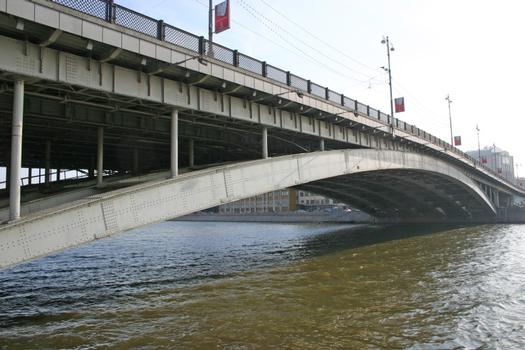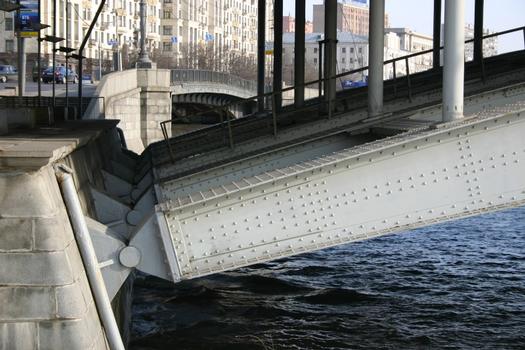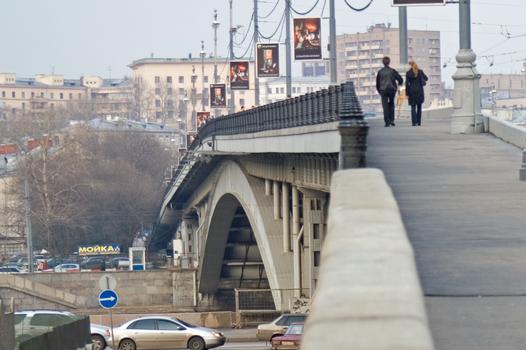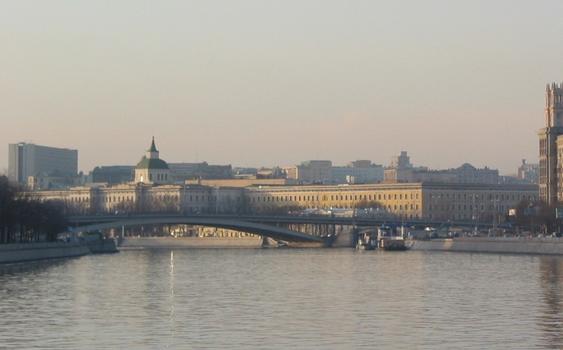General Information
| Completion: | 1938 |
|---|---|
| Status: | in use |
Project Type
| Function / usage: |
Road bridge |
|---|---|
| Structure: |
Deck arch bridge Two-hinged arch bridge |
Location
| Location: |
Moscow, Central Federal District, Russia |
|---|---|
| Crosses: |
|
| Coordinates: | 55° 44' 49" N 37° 38' 19" E |
Technical Information
Dimensions
| main span | 134 m | |
| length | 478 m | |
| main bridge | ||
|---|---|---|
| span lengths | 50.5 m - 134.0 m - 50.5 m | |
| number of spans | 3 | |
Chronology
| 1999 — 2000 | Deck replacement. |
|---|
Excerpt from Wikipedia
Bolshoy Ustinsky Bridge (Russian: Большой Устьинский мост) is a steel arch bridge that spans Moskva River near the mouth of Yauza River, connecting the Boulevard Ring with Zamoskvorechye district in Moscow, Russia. It was completed in May 1938 by V.M.Vakhurkin (structural engineering), G.P.Golts and D.M.Sobolev (architectural design).
History
Site of Ustinsky Bridges, 1853, from Khotev's Atlas. Large structure in upper left quarter is Foundling House(The Orphanage, 1763-1770) View of 1881 Ustinsky Bridge, Orphanage, and Kremlin. Postcard from a photograph made before 1887, when the First electrical powerplant (MoGes One) was built
The first Ustinsky Bridge across Moskva River was built in 1881, to a very common triple-span arch design by V.N.Speyer. Three spans were 39.5, 44.5 and 39.5 meters long and 19.2 meters wide (4 lanes, including two tram tracks); each span was suspended by 12 riveted arches. All downtown bridges built in 1880-1911 over Moskva River followed this triple-span shape; none survived in their original shape (Borodinsky and Novospassky still stand on original pylons, but arches were replaced with plate girders). As the archive photo shows, bridge and embankment traffic cross each other in the same level. This was probably the most important reason for replacing the bridge in the 1930s (others being insufficient width and shipping clearance).
Lower Yauza river had numerous bridges, dams and water mills since Middle Ages. The 1853 city plan shows a total of four such crossings. One was eventually demolished without replacement, three others correspond (west to east) to present-day Maly Ustinsky, Astakhovsky (Yauzsky) and Tessinsky bridges. Most important of these, Yauzsky Bridge, connecting city center with eastbound roads, was rebuilt in stone in 1804. In 1812, it was in the path of retreating Russian Army when it evacuated Moscow after Battle of Borodino. Yauzsky Bridge was renamed Astakhovsky after I.T.Astakhov, a steelworkers' leader killed on the bridge during a rally on February 28, 1917; this title remains official to date.
Before World War II, city planners intended to complete the Boulevard Ring with a link through Zamoskvorechye. This called for a bridge with higher traffic capacity, so a replacement Bolshoy Ustinsky bridge was built. Maly Ustinsky and Yauzsky (Astakhovsky) Bridge were also torn down and rebuilt to the same high capacity standard. Ring link was never completed; its planned outline can be vaguely traced by a chain of grand stalinist buildings near Tretyakovskaya metro station. Traffic through Bolshoy Ustinsky Bridge remains relatively low (unlike the busy Yauza bridges).
Bolshoy Ustinsky Bridge (1938)
The bridge is 40 meters wide and 478 meters long; main span is 134 meters long, having six parallel steel arches (span formula 50.5+134.0+50.5 meters). Orthotropic deck is supported by I-beams; there are six road lanes and two tram tracks on a raised divider. Two features make this bridge unique:
- There are no massive stone pillars: arches are set onto low pylons that do not protrude above street level. Each pylon rests on a flat slab measuring 31.2 by 40.0 meters.
- It is the only major downtown bridge that retains tram traffic (routes A, 3, 39 – the last and only tram line inside Garden Ring).
Bolshoy Ustinsky bridge was reconstructed in 1999-2000, replacing the roadway deck with an improved, lighter orthotropic type. It retained all original structural details.
Text imported from Wikipedia article "Bolshoy Ustinsky Bridge" and modified on July 23, 2019 according to the CC-BY-SA 4.0 International license.
Participants
- Georgy Golts (architect)
- D. M. Sobolev (architect)
- V. M. Vakhurkin (engineer)
Relevant Web Sites
Relevant Publications
- (2004): Мосты Москвы. Вече, Moscow (Russia), pp. 83-87.
- About this
data sheet - Structure-ID
20019485 - Published on:
12/02/2006 - Last updated on:
05/02/2016










